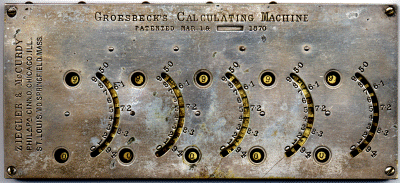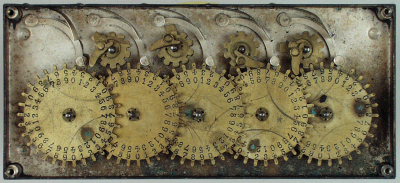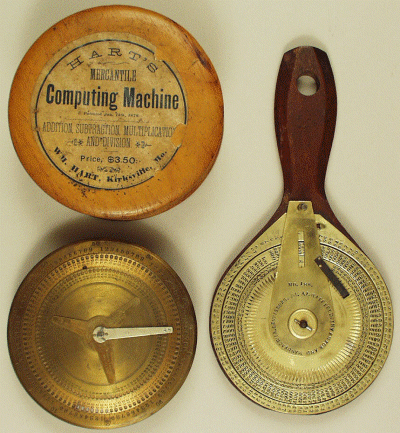Small Adders Part 4
Bob Otnes, Palo Alto, California
Teil 4 des Vortrags, gehalten beim 2. Greifswalder Symposium zur Entwicklung der Rechentechnik 12. - 14. September 2003, erschienen in Girbardt/Schmidt 9-2003
Im Rechnerlexikon mit freundlicher Genehmigung des Verfassers
- Small Adders
- Small Adders Part 1: Acknowledgements, Types of Adders
- Small Adders Part 2: Taxonomy
- Small Adders Part 3: Dial Column Adders, Keyed Column Adders
- Small Adders Part 4: Dials in a Row, Concentric Dial Adders
- Small Adders Part 5:The Kummer Adder, Chain Input, Miscellaneous
|
1 Small Adders Part 4
1.1 Category 2.1.1 - Dials in a Row

Outside of the Roth Adder- 1843.

Outside of the Groesbeck Adder - 1870.

Front side of the Lehre/Harrison Adder, 1957,  US2797047 (espacenet),
US2797047 (espacenet),  US2797047 (uspto).
US2797047 (uspto).

Outside of the Bair Adder- 1933 (There is no inside).
The above group shows the front of four dial adders. They are shown together because of their somewhat different mechanisms. The Roth's operation appears to be actuated by springs, Whereas the Groesbeck, except for detents, is geared. The Lehre/Harrison is geared and will directly add and subtract. The Bair adder, similar to the Arithmographe de Clabor (1906) has no mechanism. It is essentially a Kummer.
Inside the Four Dials in Row Machines

Inside of the Roth Adder, 1843

Inside of the Groesbeck Adder, 1870
1.2 Category 2.1.2 - Concentric Dial Adders

Two Early Concentric Dial Adders
On the left is the Hart adder of 1878 with its wooden case. On the right is the Hatfield of 1854. The Hatfield does not use a stylus: to operate it, you start with the arm at the stop, turn the arm counterclockwise until the number you desire to add appears in the window, and then turn the arm back to the stop; in doing this, the leaf spring engages one of the slots on the inner wheel, and turns that wheel to the new position, thus showing the updated sum. When you go past "blank" (there is neither a zero nor 100 at that location), the outer movable dial moves one position. Total capacity is 9999. Curiously, the outer movable dial has two unneeded zeros at each position. The example has a serial number of 188. The Hart (1878) is later and was probably made to compete with the early Webb Adder. It needs a stylus, with the other hand holding on to a wooden knob on the back of the adder. Like the Hatfield, the capacity is 9999. The carrying action is so simple that it is almost di_cult to see. It is much easier to clear than the Hatfield, and appears to be better made.
- Small Adders
- Small Adders Part 1: Acknowledgements, Types of Adders
- Small Adders Part 2: Taxonomy
- Small Adders Part 3: Dial Column Adders, Keyed Column Adders
- Small Adders Part 4: Dials in a Row, Concentric Dial Adders
- Small Adders Part 5:The Kummer Adder, Chain Input, Miscellaneous
2 Copyright
Alle Rechte beim Verfasser
Please do not copy or reprint
Dieses Material ist Bestandteil eines Buches von Bob Otnes, das voraussichtlich noch im Jahre 2004 erscheinen wird.
Diese Seite ist geschützt. Sie darf nur
vom Autor oder einer beauftragten Person verändert werden.
Falls Sie mit dem Inhalt nicht einverstanden sind,
machen Sie bitte einen Eintrag bei der Diskussion und schicken dem Autor eine Mail.
![[Hauptseite]](/upload/wiki.png)
 Hauptseite
Hauptseite
